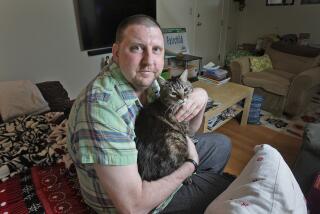Karen Ann Quinlan’s Parents Reflect on Painful Decision 20 Years Later
- Share via
WANTAGE TOWNSHIP, N.J. — Julia and Joseph Quinlan remember their daughter as a vibrant tomboy who taught her younger brother to wrestle, a young woman with a beautiful voice who dreamed of being a singer.
Most Americans recall Karen Ann Quinlan as the comatose woman in a black-and-white photograph published around the world, whose life on a ventilator led to the nation’s first major right-to-die case.
Twenty years ago, the New Jersey Supreme Court ruled that the Quinlans had the right to take their daughter off life-support equipment. Since then, dozens of court rulings and scores of laws have backed that right.
“They say we were the pioneers. I guess we were. We just did what we had to do,” Joseph Quinlan, a former pharmaceutical executive, said at the family’s hilltop home in rural western New Jersey.
The Quinlan case was a direct outgrowth of a revolution in life-sustaining technology in the 1950s and ‘60s. Patients no longer died simply at home; many lingered for weeks or months, kept alive by machines.
Today, about 75% of Americans die in institutions, many after decisions to withhold life-sustaining assistance, said John Fletcher, director of the Center for Biomedical Ethics at the University of Virginia.
“The case was the first one to draw the attention of the country and the courts to the problem of being a prisoner in a helpless body, supported only by medical technology,” Fletcher said.
“Death is not something that just happens to most people. Nowadays it’s death by decision,” he added. “Every one of those decisions is a direct descendant of the Quinlan decision.”
Karen Ann Quinlan was 21 when she slipped into a coma at a party April 15, 1975. Although the cause was never established, party guests said she had several gin and tonics on top of a mild tranquilizer.
Weeks passed. Her condition did not improve, and every breath the ventilator forced into her lungs was clearly uncomfortable. The Quinlans decided to take her off the machine and end her pain.
“That decision was so difficult for me. I was the last holdout. I did a lot of praying for guidance,” Joseph Quinlan said. Devout Catholics, the couple consulted with their priest, who supported the decision.
But the doctors at St. Clare’s Hospital in Denville refused to comply. The Quinlans went to court and “our privacy was totally erased after that,” Julia Quinlan said.
On March 31, 1976, the state Supreme Court ruled unanimously.
“No compelling interest of the state could compel Karen to endure the unendurable, only to vegetate a few measurable months with no realistic possibility of returning to any semblance of cognitive or sapient state,” then-Chief Justice Richard Hughes wrote.
Karen was removed from her respirator in May 1976. When she did not die as expected, she was moved to a nursing home.
The case opened widespread debate about whether it was always in patients’ best interests to keep them alive artificially.
The next year, California passed a law recognizing the legality of living wills--advance directives telling doctors how an individual wants to be treated when deemed incompetent or unable to communicate.
Now all states have laws governing living wills or granting durable power of attorney, which allows a person to designate another to make life-and-death decisions in the event of incompetence.
More than 20% of Americans have living wills, said Karen Orloff Kaplan, executive director of Choice in Dying, a Manhattan-based organization.
Most states allow family members to make decisions for their loved ones even without prior documentation. But some, New York and Missouri among them, require clear and convincing evidence that the patient, if competent, would have agreed with the decision, said Bruce Jennings, executive director of The Hastings Center, a medical ethics think tank in Briarcliff Manor, N.Y.
The U.S. Supreme Court did not take up the issue until 1990 when it heard the case of Nancy Cruzan, a Missouri woman who lingered eight years in a permanent vegetative state.
The court ruled that adults had a constitutional right to refuse medical treatment but said Cruzan’s parents had not offered “clear and convincing” evidence that she would have wanted to die.
When Cruzan’s parents later produced evidence of her wishes, federal and Missouri courts allowed her parents to remove her feeding tube. She died Dec. 26, 1990.
Karen Ann Quinlan’s parents never sought to have her feeding tube removed during the nine years she lived after she was taken off the respirator. She died June 11, 1985.
“We never asked to have her die. We just asked to have her put back in a natural state so she could die in God’s time,” Julia Quinlan said.
The Quinlans remember her still as an athletic girl who loved to sing and had planned to study music. A lifeguard, she skied and water-skied, played football and baseball, taught her brother to wrestle.
“She loved life. She always smiled. She had great laughter, she loved to laugh,” Julia Quinlan said.
Her parents used the proceeds of a book and a television movie to start the Karen Ann Quinlan Center of Hope Hospice in Newton. Its home-care program allows terminally ill people to die at home, surrounded by family members.
The Quinlans now put their energies into the hospice. They live in a house overlooking miles of flowing valleys and mountains. In the living room, sitting on a table, is the famous photo of Karen, frozen forever at 21.
More to Read
Sign up for Essential California
The most important California stories and recommendations in your inbox every morning.
You may occasionally receive promotional content from the Los Angeles Times.













